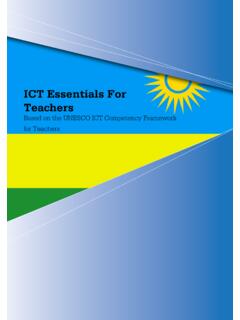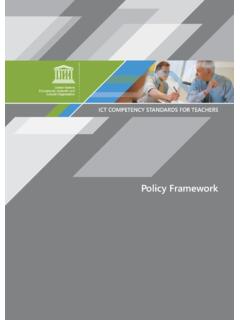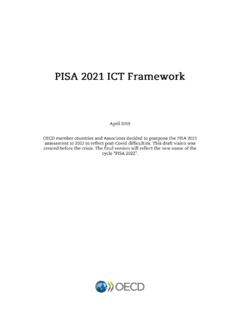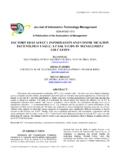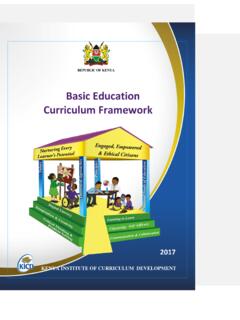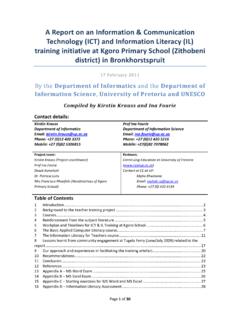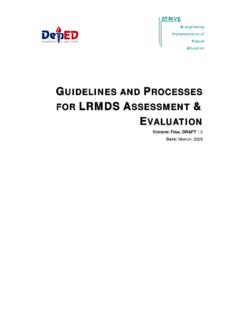Transcription of KENYA INSTITUTE OF CURRICULUM DEVELOPMENT
1 KENYA INSTITUTE OF CURRICULUM DEVELOPMENT Facilitator s Training Manual For Early Years Education CURRICULUM November 2017 1 Table of Contents INTRODUCTION .. 2 Aims of the Training .. 2 How to Use the Manual .. 2 Proposed Programme for the teacher Training .. 4 SESSION 1: Basic Education CURRICULUM framework .. 6 Core competencies .. 8 Organization of Basic Education .. 9 Learning areas for Early Years Education .. 9 SESSION 2: Competence Based CURRICULUM for Learners with Special Needs .. 10 Developed curricula for learners with special needs .. 12 SESSION 3: Interpretation of the CURRICULUM Designs .. 12 Learning outcomes .. 15 Key Inquiry Questions .. 16 Learning experiences .. 18 Learning Resources .. 20 SESSION 4: Professional Documents .. 22 Schemes of Work .. 23 Lesson Plan .. 26 Record of Work .. 31 Learner s Progress Records .. 32 SESSION 5: ICT Integration in CBC Implementation (1 hour).
2 39 Technologies used in teaching and learning .. 40 SESSION 8: Infusing Competence Aspects in Early Grade Mathematics .. 52 SESSION 9 Role of Key stakeholders in Implementation of CBC (30 Minutes pm) .. 68 2 INTRODUCTION KENYA INSTITUTE of CURRICULUM DEVELOPMENT (KICD) has developed CURRICULUM designs for Early Years Education (EYE) as part of the CURRICULUM reforms materials. The INSTITUTE has also developed a Basic Education CURRICULUM framework (BECF) to help education stakeholders better understand the CURRICULUM to enhance efficient CURRICULUM delivery. The BECF has adopted the Competency Based CURRICULUM (CBC). This has been informed various policy documents such as KENYA Vision 2030, Constitution of KENYA 2010, the Task Force report on the Re-alignment of the Education Sector to the chaired by Professor Odhiambo, the Sessional Paper No. 2 of 2015 on Reforming Education and Training.
3 Other documents that informed the CURRICULUM reforms include the 21st Century skills, the harmonized CURRICULUM for the East African States, the sustainable DEVELOPMENT goals and KICD needs assessment report 2016 among other documents formed the basis of the CURRICULUM reforms. The INSTITUTE has organised an elaborate teacher training for the national roll out of the CURRICULUM , which will be in January 2018. As part of the preparation for the roll out KICD has developed this Facilitators Training Manual to enable training of CURRICULUM implementers for efficient CURRICULUM implementation. Aims of the Training The aims of the training are as follows: a) Prepare teachers, education officers and other CURRICULUM implementers and supervisors are adequately prepared for the national roll out. The training aims to b) Equip teachers with the necessary skills to implement the competency based CURRICULUM using the Inquiry Based learning approach.
4 C) Equip teachers to facilitate differentiated learning to ensure that all learners are wholly engaged in learning. The training will focus on the Basic Education CURRICULUM framework , Special needs education, Interpretation of the CURRICULUM designs, Professional documents and integration of ICT in CURRICULUM implementation. How to Use the Manual The Facilitators Manual guides the teacher on how to implement the CURRICULUM designs for EYE. It provides the facilitators with a programme for training the teachers. It outlines the different 3 session and provides session outcomes, the key Areas to cover in each session and gives suggestion for the learning strategies that can be employed. Also provided for the facilitator is the Facilitators Notes for each session to guide on what is expected to be covered the manual. Also emphasized is the importance of preparing professional documents and how to mainstream ICT in teaching and learning.
5 Special needs education has also been highlighted as a special component in the CURRICULUM reforms. The lesson Key Inquiry Questions have also been provided. The facilitator should plan where to plug-in the question during the session to ensure that all learners are able to answer them appropriately by the end of the session The manual is an important reference for facilitators. However, the facilitator will also have to use the Basic Education CURRICULUM framework and the CURRICULUM designs alongside this manual to effectively train the teachers. The facilitator is advised to read the manual before embarking into the training programme. The manual should be in session planning and implementation. The manual will help in preparation for the training and provides suggestions for activities that the facilitator can use. The facilitator is advised to choose the activities that they are able to use depending on their situation.
6 The facilitator should use competency based approaches to facilitate the trainings. The training will also involve training of teachers in SNE institutions. The facilitator should ensure that during group activities, teachers of respective categories of learners with SNE sit together in order for them to have a walk through in the adapted and specialist design. A sample programme for training has been provided. The facilitator can adjust the programme depending on the amount of time available. Where a third day is available micro teaching is encouraged to give teacher opportunities to practice what is learnt. The manual is divided into sessions. Each session has its session outcomes that the facilitator is expected to achieve. The manual has provided information for the facilitator to help mainstream ICT in a seamless manner. Where charts, ICT gadgets and other resources are advised, the facilitator should plan ahead of the session to have them available to avoid wasting time.
7 During the training sessions, participants will be put in groups based on learning areas. These groups should remain until the end of the training. 4 Proposed Programme for the teacher Training TIME ACTIVITY DAY 1 Registration of participants Introduction Opening remarks Ground rules Workshop Aims Session 1:Basic Education CURRICULUM framework Session 2: Competency based CURRICULUM for learners with special needs am TEA BREAK am Session 3: Part 1 - Interpretation of the CURRICULUM designs National Goals of Education Level learning outcomes Learning areas for EYE - Essence statements pm Part 2- Interpretation of the CURRICULUM designs (Cont.) Interrelationship between National Goals of Education, Level Learning Outcomes, General and Specific Learning Outcomes, Strands and sub-strands. Learning Outcomes Key Inquiry Questions LUNCH BREAK pm Part 3- Interpretation of the CURRICULUM designs (Cont.)
8 Learning Experiences (Differentiated learning (inclusive education) ,Inquiry Based learning), Core Competencies, Values, PCIs) Learning resources Competency Based Assessment pm Session 4: Professional Documents Schemes of Work pm TEA BREAK DAY 2 am Preliminaries am Session 4: Professional Documents (cont) Lesson Plans am Professional Documents (cont.) Record of Work am TEA BREAK pm Professional Documents (cont.) Learner s Progress Records Individualized Education Programme (IEP pm Session 5: ICT integration in CURRICULUM implementation pm LUNCH BREAK 5 pm Infusing Competency Based Aspects in English and Kiswahili Language (We do) pm Infusing Competency Based Aspects in English and Kiswahili Language (I do) 5:30 TEA BREAK DAY 3 8:30 8:45 am Registration, Welcome and Announcements 8:45 9:35 am Infusing new CURRICULUM in EGM 9:35 10:35 am Rote counting & Counting on 10:35 11:05 am TEA BREAK 11:05 12:05 pm Addition by Breaking Apart 12:05 1:05 pm Subtraction by Breaking Apart 1:05 2:00 pm LUNCH BREAK 2:00 2:50 pm Number Patterns 2:50 3:50 pm Place value 3:50 4:50 pm Addition by regrouping 4:50 5:00 pm Homework DAY 4 8:30 8:45 am Registration, Welcome and Announcements 8:45 9:45 am Equivalence 9:45 10.
9 40 am Fractions(Introduction, I do, We do) 10:40 11:10 am TEA BREAK 11:10 12:10 pm Geometry 12:10 1:00 pm Measurement (Length) 1:00 2:00 pm LUNCH BREAK 2:00 2:50 pm Addition & Subtraction of Length in Metres 2:50 4:00 pm Putting it all together 4:00 Plenary 6 Day 1 SESSION 1: Basic Education CURRICULUM framework (1 hour) Session Outcomes By the end of the session, the participant should be able to: a) Discuss the Basic Education CURRICULUM framework to professionally implement the CURRICULUM . b) Appreciate the Basic Education CURRICULUM framework for effective implementation of CURRICULUM . Key Areas to be covered Basic Education CURRICULUM framework Mission and Vision statements National Goals of Education Pillars of the BECF Core competencies Organisation of basic education Learning areas for EYE Suggested Learning Experiences Buzz on the vision and mission statements Reflect on the national goals of education Brainstorm on the importance of the core competencies Discuss the organisation of basic education Question and answer Facilitators Notes Vision: Engaged, Empowered, and Ethical Citizen Mission: Nurturing Every Learner s Potential National Goals of Education 1.
10 Foster nationalism, patriotism, and promote national unity 2. Promote social, economic, technological and industrial needs for national DEVELOPMENT 3. Promote individual DEVELOPMENT and self-fulfilment 4 Promote sound moral and religious values 5. Promote social equity and responsibility 6. Promote respect for and DEVELOPMENT of KENYA s rich and varied cultures 7. Promote international consciousness and foster positive attitudes towards other nations 8. Promote positive attitudes towards good health and environmental protection 7 Pillars of BECF 1. Value based education Love Responsibility Respect Unity Peace Patriotism Social Justice Integrity 2. Principles of BECF Opportunity Excellence Diversity Inclusion Parental Empowerment and Engagement Community Service Learning Differentiated CURRICULUM and Learning 3. Theoretical Approaches The Instructional Design Theory Vygotsky s Sociocultural Theory.



